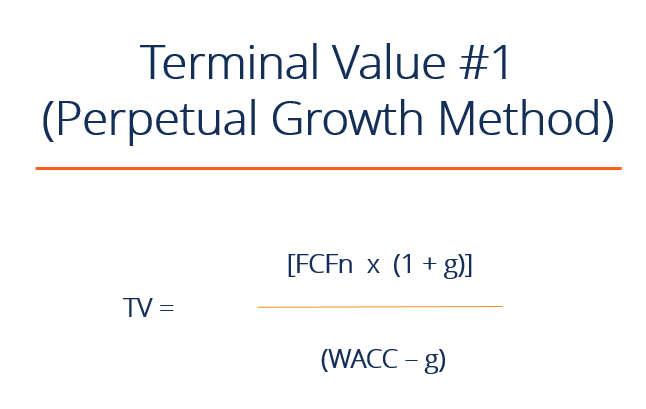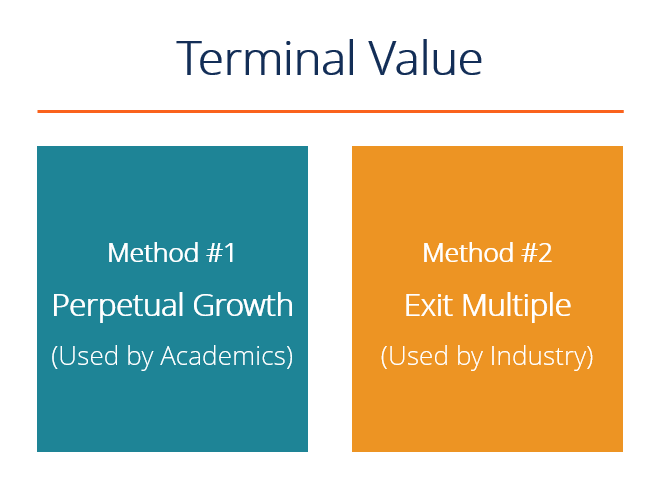- What is the DCF Terminal Value Formula?
- Why is a Terminal Value Used?
- What is the Perpetual Growth DCF Terminal Value Formula?
- What is the Exit Multiple DCF Terminal Value Formula?
- Which Terminal Value Method is More Common?
- Example from a Financial Model
- Download CFI's Free DCF Model Template
- Video Explanation of Terminal Value
- More Valuation Resources
DCF Terminal Value Formula
What terminal value is, how to calculate it, and how it's used in a DCF analysis
What is the DCF Terminal Value Formula?
Terminal value is the estimated value of a business beyond the explicit forecast period. It is a critical part of the financial model, as it typically makes up a large percentage of the total value of a business. There are two approaches to the DCF terminal value formula: (1) perpetual growth, and (2) exit multiple.
Image: CFI’s Business Valuation Course.
Why is a Terminal Value Used?
When building a Discounted Cash Flow / DCF model, there are two major components: (1) the forecast period and (2) the terminal value.
The forecast period is typically 3-5 years for a normal business (but can be much longer in some types of businesses, such as oil and gas or mining) because this is a reasonable amount of time to make detailed assumptions. Anything beyond that becomes a real guessing game, which is where the terminal value comes in.
What is the Perpetual Growth DCF Terminal Value Formula?
The perpetual growth method of calculating a terminal value formula is the preferred method among academics as it has a mathematical theory behind it. This method assumes the business will continue to generate Free Cash Flow (FCF) at a normalized state forever (perpetuity).
The formula for calculating the perpetual growth terminal value is:
TV = (FCFn x (1 + g)) / (WACC – g)

Where:
- TV = terminal value
- FCF = free cash flow
- n = year 1 of terminal period or final year
- g = perpetual growth rate of FCF
- WACC = weighted average cost of capital
What is the Exit Multiple DCF Terminal Value Formula?
The exit multiple approach assumes the business is sold for a multiple of some metric (e.g., EBITDA) based on currently observed comparable trading multiples for similar businesses.
The formula for calculating the exit multiple terminal value is:
TV = Financial Metric (e.g., EBITDA) x Trading Multiple (e.g., 10x)

Which Terminal Value Method is More Common?
The exit multiple approach is more common among industry professionals, as they prefer to compare the value of a business to something they can observe in the market. You will hear more talk about the perpetual growth model among academics since it has more theory behind it. Some industry practitioners will take a hybrid approach and use an average of both.
Example from a Financial Model
Below is an example of a DCF Model with a terminal value formula that uses the Exit Multiple approach. The model assumes an 8.0x EV/EBITDA sale of the business that closes on 12/31/2022.
As you will notice, the terminal value represents a very large proportion of the total Free Cash Flow to the Firm (FCFF). In fact, it represents approximately four times as much cash flow as the forecast period. For this reason, DCF models are very sensitive to assumptions that are made about terminal value.
A common way to help represent this is through sensitivity analysis.
Image: CFI’s Financial Modeling Course.
Download CFI’s Free DCF Model Template
Complete the form below to download our free DCF Model template!
* By submitting your email address, you consent to receive email messages (including discounts and newsletters) regarding Corporate Finance Institute and its products and services and other matters (including the products and services of Corporate Finance Institute's affiliates and other organizations). You may withdraw your consent at any time.
This request for consent is made by Corporate Finance Institute, #1392 - 1771 Robson Street, Vancouver, BC V6G 3B7, Canada. www.corporatefinanceinstitute.com. [email protected]. Please click here to view CFI`s privacy policy.
Video Explanation of Terminal Value
Below is a short video tutorial that explains how to calculate TV step by step in Excel. This example is taken from CFI’s financial modeling courses.
More Valuation Resources
To learn more about valuation and financial modeling, check out these additional CFI resources:

